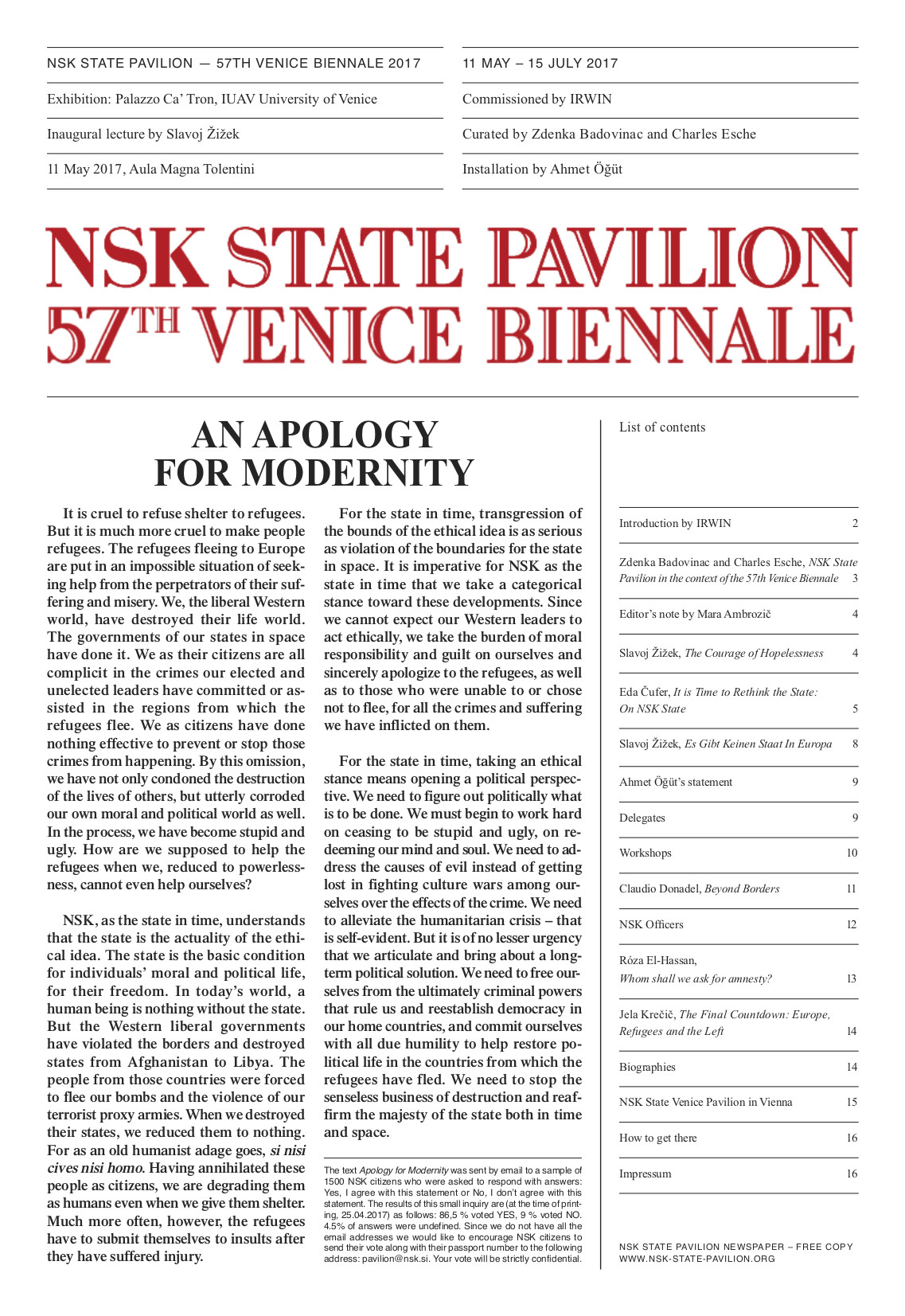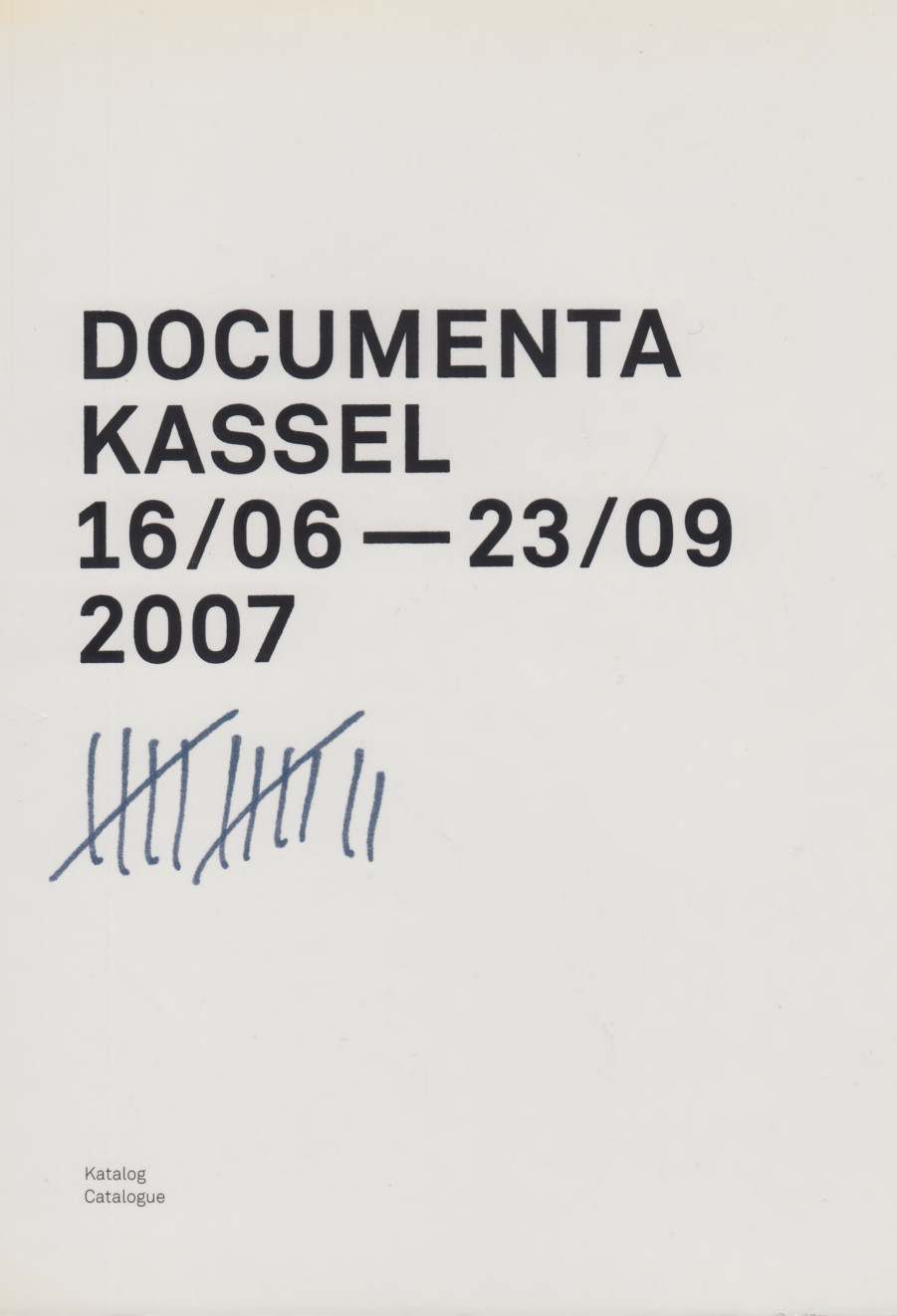NSK State Pavilion: 57th Venice Biennale (2017)
Filed under newspaper | Tags: · art, borders, migration, refugees

“NSK State in Time was founded by artist collective Neue Slowenische Kunst (NSK) in 1992. It was conceived as a utopian formation, which would have no physical territory and would not be identified with any existing nation state. Along with organising temporary embassies and consulates in cities such as Moscow, Berlin, Florence, Sarajevo and New York, NSK State in Time began issuing passports in 1993. There are currently about 15,000 NSK Passport holders around the world, with well known citizens including including Marina Abramović, John Baldessari, Boris Groys, Hans Ulrich Obrist and Slavoj Žižek.
The NSK State Pavilion provided an added and new dimension to NSK State in Time, built upon a collaboration with migrant communities, humanitarian protection applicants, and stateless individuals who are looking for new citizenship. At the Venice Biennale, the project aimed to rethink what a contemporary state can be, offering an open form of citizenship which contrasts with that generated by spatially-defined states.”
With contributions by Zdenka Badovinovac and Charles Esche, Eda Čufer, Claudio Donadel, Róza El-Hassan, Jela Krečič, and Slavoj Žižek.
Edited by Mara Ambrožič
Publisher Irwin, 2017
16 pages
documenta 12 (2007) [German/English]
Filed under catalogue | Tags: · art, contemporary art, form, migration

“For the first time in the history of the documenta, the major event in Kassel was organized under the direction of a couple: Roger M. Buergel as the designated art director and Ruth Noack as curator. They served only “unofficially” as a two-member directorial team, however, as the documenta statutes do not allow for the possibility of two co-directors. Together, they developed a clearly defined programmatic concept under the banner of “The Migration of Forms.” What that meant was that, over the course of human history, visual culture has had only a limited number of basic forms with which to work—forms that have been used in different contexts and with different conceptual focuses throughout the history of art. Buergel/Noack pointed out that “contemporary does not mean that the works originated yesterday. They must be meaningful for people today. Documenta 12 is concerned with both historical lines of development in art and unexpected concurrences.” In order to bring these “unexpected concurrences” to light, relationships were established between works of art from different decades and cultures in which similar formal patterns have emerged—a process that has led to a “migration” of aesthetic forms across temporal and cultural boundaries culminating in the art of our postmodern world. This formalism was emphasized in the Neue Galerie by walls painted different colors. In turn, this focus on the phenomenon of migration resulted in the selection of a high percentage of artists from Africa, Asia, and Eastern Europe. New to the program was the inclusion of old art, from fourteenthcentury Persian miniatures to global art from recent decades. Artists already long since recognized in their own homelands, such as Nasreen Mohamedi, for example, were not the only ones presented to a broad public in Germany for the first time. The works of several exemplary artists—John McCracken, Kerry James Marshall, Charlotte Poseneske, and Gerwald Rockenschaub—also migrated through all exhibition venues.” (Source)
Publisher Taschen, Cologne, 2007
ISBN 9783836500524, 3836500523
415 pages
via x
PDF (148 MB, no OCR)
Comment (0)Near Futures Online, 1: Europe at a Crossroads (2016)
Filed under journal | Tags: · democracy, economics, eu, europe, governance, greece, immigration, left, migration, neoliberalism, politics, refugees

“Europe at a Crossroads, the pilot issue of Near Futures Online, examines the recent history and potential fate of the two faces of “crisis” in today’s Europe, namely: the resistance and eventual surrender of the Greek government to the dictates of its creditors, and the growing tensions regarding the reception of asylum seekers and the place of immigrants in the EU.”
“Near Futures Online, the online companion of Zone Books’ Near Futures series, is a forum dedicated to the analysis of the challenges borne out of national governments’ and international institutions’ responses to some critical events – the financial crisis of 2008, the “Arab Springs” of 2011 – as well as ongoing developments such as climate change and soaring inequalities. Organized around a specific question, each issue of NFO brings together scholars, journalists, political activists, and artists, and includes contributions belonging to different genres and using a variety of media – essays and reportages, interviews and dialogues, photo essays and videos. Contributors are invited to address questions raised by NFO through an engagement with particular debates, histories, policies, and actors as well as to examine their possible trajectories in the near future.”
Edited by Michel Feher, William Callison, Milad Odabaei, and Aurélie Windels
Publisher Zone Books, Mar 2016
Open access

